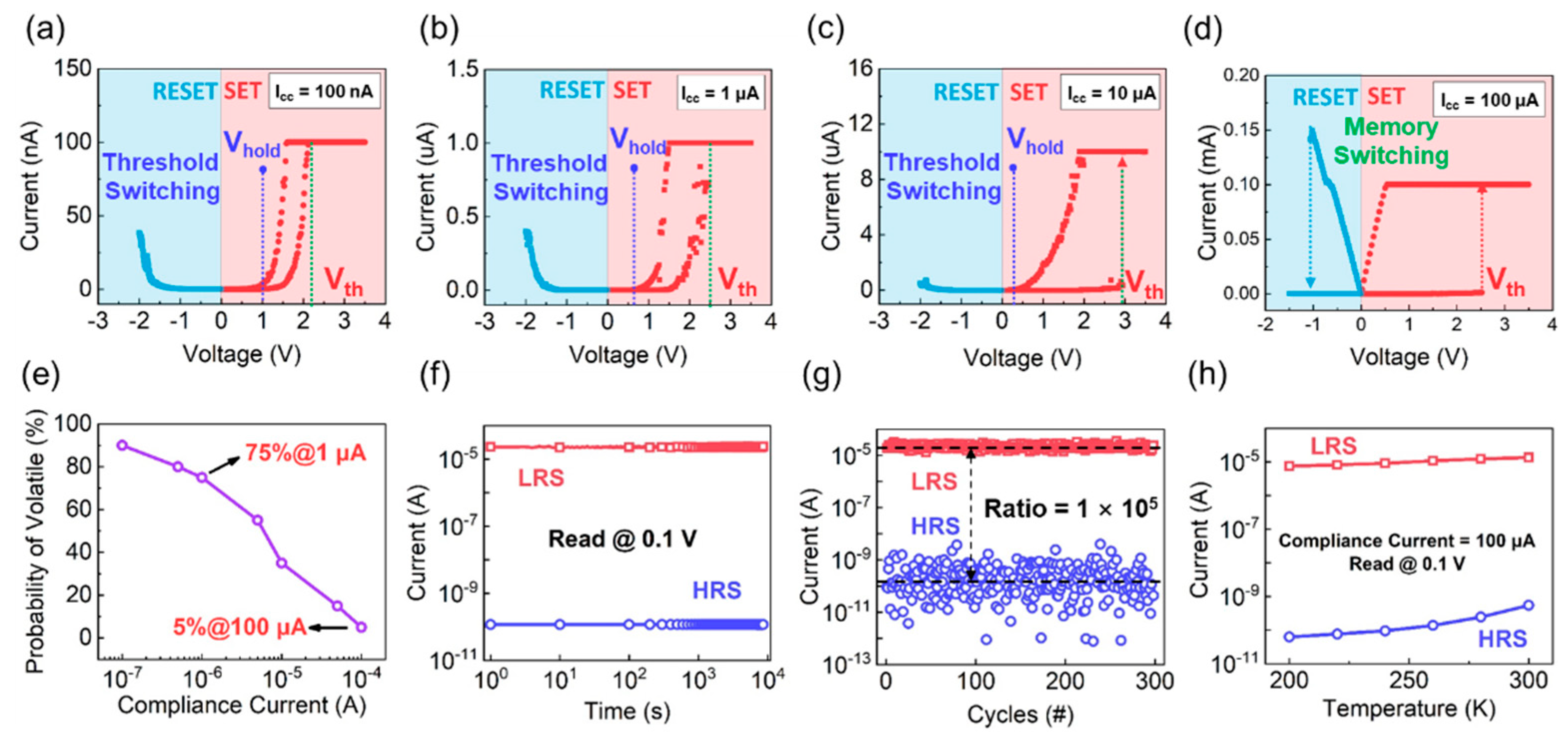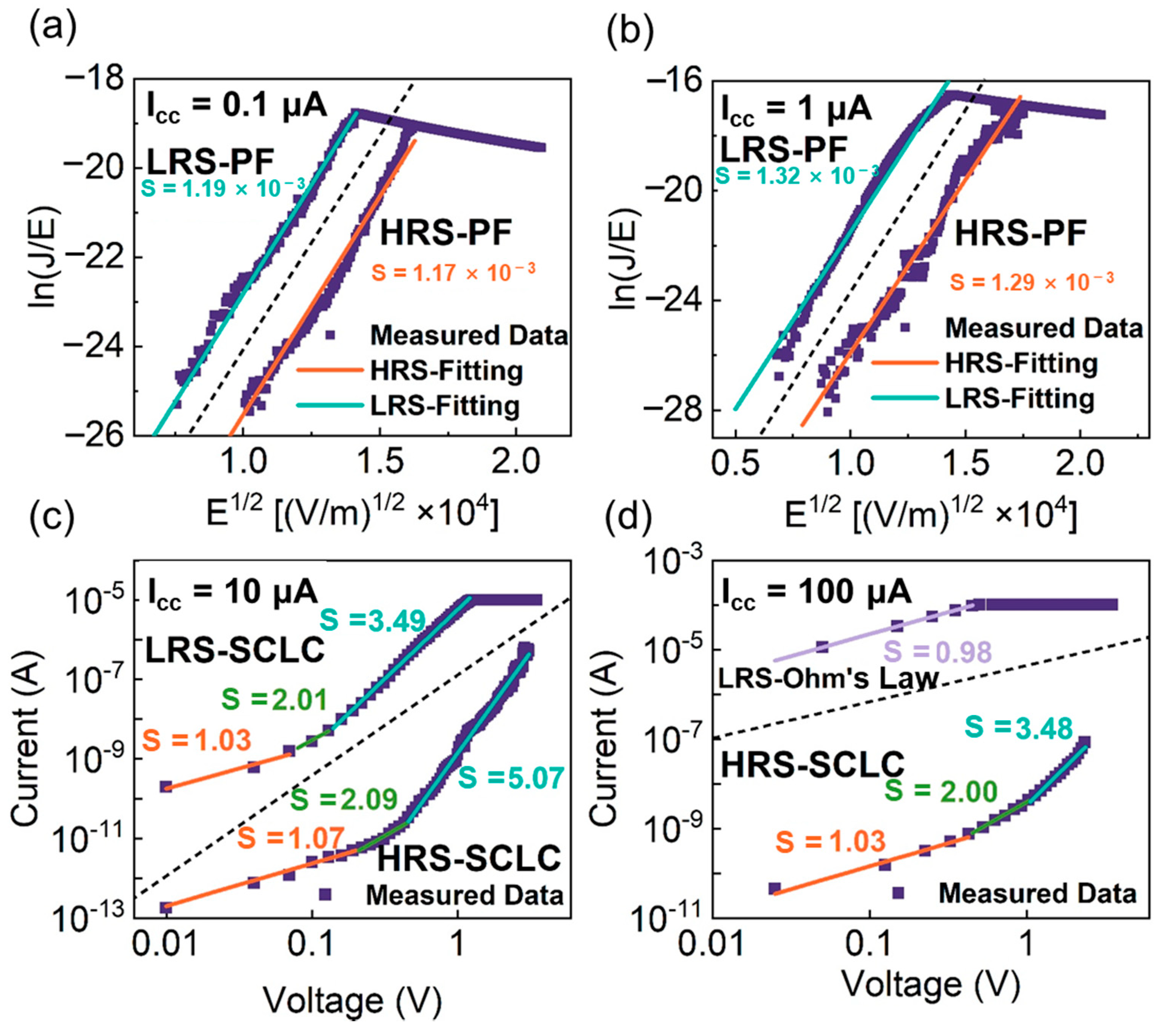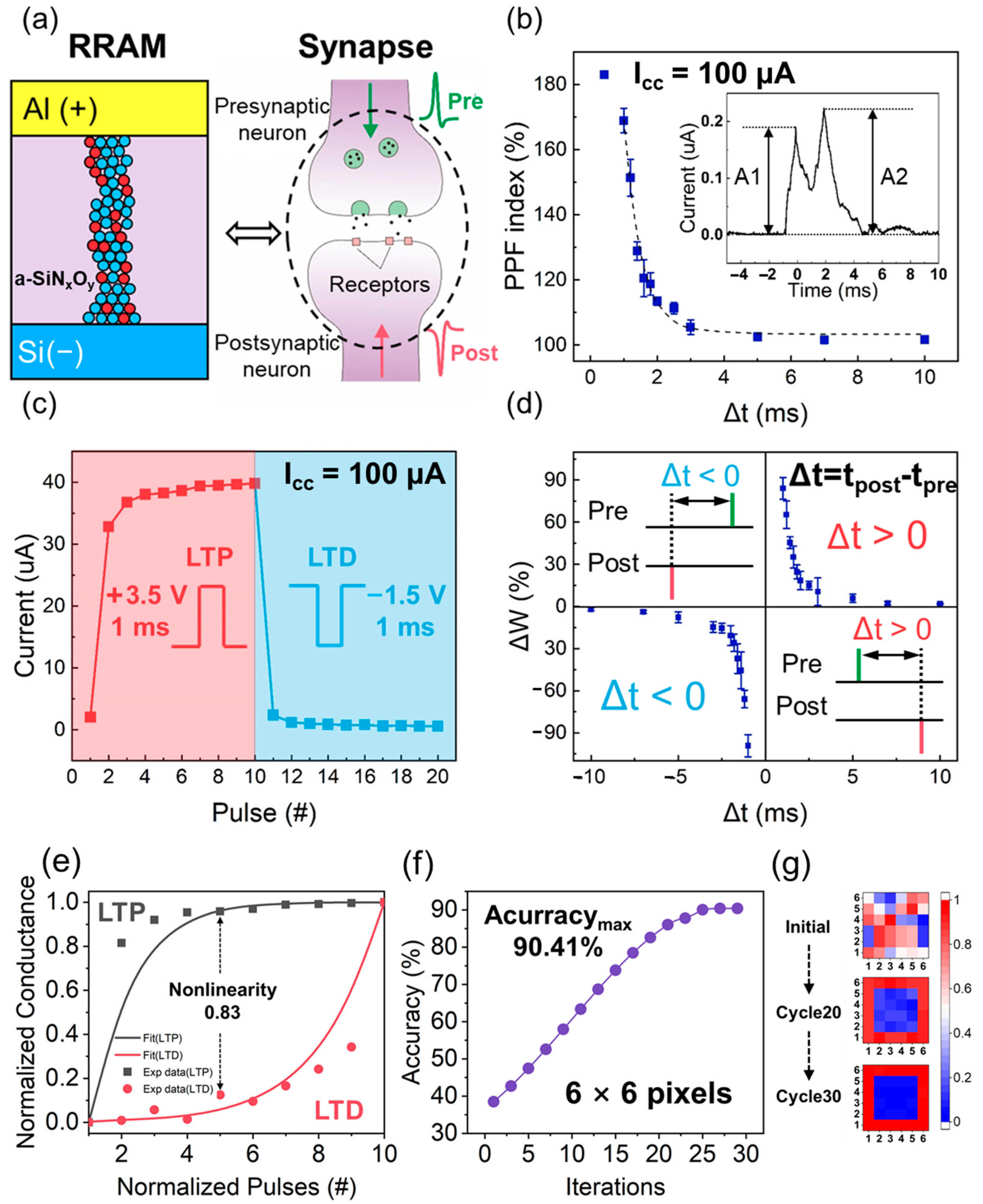Artificial Neurons and Synapses Based on Al/a-SiNxOy:H/P+-Si Device with Tunable Resistive Switching from Threshold to Memory
Abstract
:1. Introduction
2. Materials and Methods
3. Results
4. Conclusions
Author Contributions
Funding
Institutional Review Board Statement
Informed Consent Statement
Data Availability Statement
Conflicts of Interest
References
- Yoon, K.J.; Kim, Y.; Hwang, C.S. What Will Come After V-NAND—Vertical Resistive Switching Memory? Adv. Electron. Mater. 2019, 5, 1800914. [Google Scholar] [CrossRef]
- Qu, T.; Sun, Y.; Chen, M.; Liu, Z.; Zhu, Q.; Wang, B.; Zhao, T.; Liu, C.; Tan, J.; Qiu, S.; et al. A Flexible Carbon Nanotube Sen-Memory Device. Adv. Mater. 2020, 32, 1907288. [Google Scholar] [CrossRef] [PubMed]
- Tian, H.; Deng, B.; Chin, M.L.; Yan, X.; Jiang, H.; Han, S.-J.; Sun, V.; Xia, Q.; Dubey, M.; Xia, F.; et al. A Dynamically Reconfigurable Ambipolar Black Phosphorus Memory Device. ACS Nano 2016, 10, 10428–10435. [Google Scholar] [CrossRef]
- Lyu, B.; Choi, Y.; Jing, H.; Qian, C.; Kang, H.; Lee, S.; Cho, J.H. 2D MXene–TiO2 Core–Shell Nanosheets as a Data-Storage Medium in Memory Devices. Adv. Mater. 2020, 32, 1907633. [Google Scholar] [CrossRef] [PubMed]
- Xia, Q.; Yang, J.J. Memristive Crossbar Arrays for Brain-Inspired Computing. Nat. Mater. 2019, 18, 309–323. [Google Scholar] [CrossRef] [PubMed]
- Kwon, D.-H.; Kim, K.M.; Jang, J.H.; Jeon, J.M.; Lee, M.H.; Kim, G.H.; Li, X.-S.; Park, G.-S.; Lee, B.; Han, S.; et al. Atomic Structure of Conducting Nanofilaments in TiO2 Resistive Switching Memory. Nat. Nanotech 2010, 5, 148–153. [Google Scholar] [CrossRef] [PubMed]
- Yeon, H.; Lin, P.; Choi, C.; Tan, S.H.; Park, Y.; Lee, D.; Lee, J.; Xu, F.; Gao, B.; Wu, H.; et al. Alloying Conducting Channels for Reliable Neuromorphic Computing. Nat. Nanotechnol. 2020, 15, 574–579. [Google Scholar] [CrossRef]
- Banerjee, W.; Kim, S.H.; Lee, S.; Lee, S.; Lee, D.; Hwang, H. Deep Insight into Steep-Slope Threshold Switching with Record Selectivity (>4 × 1010) Controlled by Metal-Ion Movement through Vacancy-Induced-Percolation Path: Quantum-Level Control of Hybrid-Filament. Adv. Funct. Mater. 2021, 31, 2104054. [Google Scholar] [CrossRef]
- Molas, G.; Vianello, E.; Dahmani, F.; Barci, M.; Blaise, P.; Guy, J.; Toffoli, A.; Bernard, M.; Roule, A.; Pierre, F.; et al. Controlling Oxygen Vacancies in Doped Oxide Based CBRAM for Improved Memory Performances. In Proceedings of the 2014 IEEE International Electron Devices Meeting, San Francisco, CA, USA, 15 December 2014; pp. 6.1.1–6.1.4. [Google Scholar]
- Moon, K.; Lim, S.; Park, J.; Sung, C.; Oh, S.; Woo, J.; Lee, J.; Hwang, H. RRAM-Based Synapse Devices for Neuromorphic Systems. Faraday Discuss. 2019, 213, 421–451. [Google Scholar] [CrossRef] [PubMed]
- Banerjee, W. Challenges and Applications of Emerging Nonvolatile Memory Devices. Electronics 2020, 9, 1029. [Google Scholar] [CrossRef]
- Hong, X.; Loy, D.J.; Dananjaya, P.A.; Tan, F.; Ng, C.; Lew, W. Oxide-Based RRAM Materials for Neuromorphic Computing. J. Mater. Sci. 2018, 53, 8720–8746. [Google Scholar] [CrossRef]
- Ielmini, D. Brain-Inspired Computing with Resistive Switching Memory (RRAM): Devices, Synapses and Neural Networks. Microelectron. Eng. 2018, 190, 44–53. [Google Scholar] [CrossRef]
- Waser, R.; Dittmann, R.; Staikov, G.; Szot, K. Redox-Based Resistive Switching Memories-Nanoionic Mechanisms, Prospects, and Challenges. Adv. Mater. 2009, 21, 2632–2663. [Google Scholar] [CrossRef]
- Zhao, X.; Fan, Z.; Xu, H.; Wang, Z.; Xu, J.; Ma, J.; Liu, Y. Reversible Alternation between Bipolar and Unipolar Resistive Switching in Ag/MoS2/Au Structure for Multilevel Flexible Memory. J. Mater. Chem. C 2018, 6, 7195–7200. [Google Scholar] [CrossRef]
- Dearnaley, G.; Stoneham, A.M.; Morgan, D.V. Electrical Phenomena in Amorphous Oxide Films. Rep. Prog. Phys. 1970, 33, 1129–1191. [Google Scholar] [CrossRef] [Green Version]
- Adler, D.; Shur, M.S.; Silver, M.; Ovshinsky, S.R. Threshold Switching in Chalcogenide-glass. Thin. Films J. Appl. Phys. 1980, 51, 3289–3309. [Google Scholar] [CrossRef]
- Li, Y.; Tang, J.; Gao, B.; Sun, W.; Hua, Q.; Zhang, W.; Li, X.; Zhang, W.; Qian, H.; Wu, H. High-Uniformity Threshold Switching HfO2-Based Selectors with Patterned Ag Nanodots. Adv. Sci. 2020, 7, 2002251. [Google Scholar] [CrossRef] [PubMed]
- Xu, R.; Jang, H.; Lee, M.-H.; Amanov, D.; Cho, Y.; Kim, H.; Park, S.; Shin, H.; Ham, D. Vertical MoS2 Double-Layer Memristor with Electrochemical Metallization as an Atomic-Scale Synapse with Switching Thresholds Approaching 100 mV. Nano Lett. 2019, 19, 2411–2417. [Google Scholar] [CrossRef] [PubMed]
- Hubbard, W.A.; Kerelsky, A.; Jasmin, G.; White, E.R.; Lodico, J.; Mecklenburg, M.; Regan, B.C. Nanofilament Formation and Regeneration During Cu/Al2O3 Resistive Memory Switching. Nano Lett. 2015, 15, 3983–3987. [Google Scholar] [CrossRef] [PubMed] [Green Version]
- Chen, Y.-S.; Lee, H.-Y.; Chen, P.-S.; Wu, T.-Y.; Wang, C.-C.; Tzeng, P.-J.; Chen, F.; Tsai, M.-J.; Lien, C. An Ultrathin Forming-Free HfOx Resistance Memory With Excellent Electrical Performance. IEEE Electron Device Lett. 2010, 31, 1473–1475. [Google Scholar] [CrossRef]
- Li, H.; Huang, X.; Yuan, J.; Lu, Y.; Wan, T.; Li, Y.; Xue, K.; He, Y.; Xu, M.; Tong, H.; et al. Controlled Memory and Threshold Switching Behaviors in a Heterogeneous Memristor for Neuromorphic Computing. Adv. Electron. Mater. 2020, 6, 2000309. [Google Scholar] [CrossRef]
- Chang, S.H.; Lee, J.S.; Chae, S.C.; Lee, S.B.; Liu, C.; Kahng, B.; Kim, D.-W.; Noh, T.W. Occurrence of Both Unipolar Memory and Threshold Resistance Switching in a NiO Film. Phys. Rev. Lett. 2009, 102, 026801. [Google Scholar] [CrossRef] [PubMed]
- Xiao, M.; Shen, D.; Futscher, M.H.; Ehrler, B.; Musselman, K.P.; Duley, W.W.; Zhou, Y.N. Threshold Switching in Single Metal-Oxide Nanobelt Devices Emulating an Artificial Nociceptor. Adv. Electron. Mater. 2020, 6, 1900595. [Google Scholar] [CrossRef]
- Wang, Z.; Joshi, S.; Savel’ev, S.E.; Jiang, H.; Midya, R.; Lin, P.; Hu, M.; Ge, N.; Strachan, J.P.; Li, Z.; et al. Memristors with Diffusive Dynamics as Synaptic Emulators for Neuromorphic Computing. Nat. Mater. 2017, 16, 101–108. [Google Scholar] [CrossRef] [Green Version]
- Yang, R.; Huang, H.; Guo, X. Memristive Synapses and Neurons for Bioinspired Computing. Adv. Electron. Mater. 2019, 5, 1900287. [Google Scholar] [CrossRef]
- Wang, T.-Y.; Meng, J.-L.; Rao, M.-Y.; He, Z.-Y.; Chen, L.; Zhu, H.; Sun, Q.-Q.; Ding, S.-J.; Bao, W.-Z.; Zhou, P.; et al. Three-Dimensional Nanoscale Flexible Memristor Networks with Ultralow Power for Information Transmission and Processing Application. Nano Lett. 2020, 20, 4111–4120. [Google Scholar] [CrossRef] [PubMed]
- Hong, K.; Min, K.K.; Kim, M.-H.; Bang, S.; Kim, T.-H.; Lee, D.K.; Choi, Y.J.; Kim, C.S.; Lee, J.Y.; Kim, S.; et al. Investigation of the Thermal Recovery From Reset Breakdown of a SiNx-Based RRAM. IEEE Trans. Electron Devices 2020, 67, 1600–1605. [Google Scholar] [CrossRef]
- Choi, J.; Kim, S. Coexistence of Long-Term Memory and Short-Term Memory in an SiNx-Based Memristor. Phys. Status Solidi RRL 2020, 14, 2000357. [Google Scholar] [CrossRef]
- Yen, T.J.; Chin, A.; Gritsenko, V. High Performance All Nonmetal SiNx Resistive Random Access Memory with Strong Process Dependence. Sci. Rep. 2020, 10, 2807. [Google Scholar] [CrossRef] [Green Version]
- Kärcher, R.; Ley, L.; Johnson, R.L. Electronic Structure of Hydrogenated and Unhydrogenated Amorphous SiNx (0 ≤ x ≤ 1.6) : A Photoemission Study. Phys. Rev. B 1984, 30, 1896–1910. [Google Scholar] [CrossRef]
- Hao, H.L.; Wu, L.K.; Shen, W.Z.; Dekkers, H.F.W. Origin of Visible Luminescence in Hydrogenated Amorphous Silicon Nitride. Appl. Phys. Lett. 2007, 91, 201922. [Google Scholar] [CrossRef]
- Lucovsky, G.; Yang, J.; Chao, S.S.; Tyler, J.E.; Czubatyj, W. Oxygen-Bonding Environments in Glow-Discharge-Deposited Amorphous Silicon-Hydrogen Alloy Films. Phys. Rev. B 1983, 28, 3225–3233. [Google Scholar] [CrossRef]
- Shamekh, A.M.A.; Tokuda, N.; Inokuma, T. Effects of High-Temperature Annealing on Electron Spin Resonance in SiOx Films Prepared by R. F. Sputtering System. J. Non-Cryst. Solids 2011, 357, 981–985. [Google Scholar] [CrossRef]
- McPherson, J.W.; Mogul, H.C. Underlying Physics of the Thermochemical E Model in Describing Low-Field Time-Dependent Dielectric Breakdown in SiO2 Thin Films. J. Appl. Phys. 1998, 84, 1513–1523. [Google Scholar] [CrossRef]
- Wang, Y.; Qian, X.; Chen, K.; Fang, Z.; Li, W.; Xu, J. Resistive Switching Mechanism in Silicon Highly Rich SiOx (x < 0.75) Films Based on Silicon Dangling Bonds Percolation Model. Appl. Phys. Lett. 2013, 102, 042103. [Google Scholar] [CrossRef]
- Das, N.C.; Oh, S.-I.; Rani, J.R.; Hong, S.-M.; Jang, J.-H. Multilevel Bipolar Electroforming-Free Resistive Switching Memory Based on Silicon Oxynitride. Appl. Sci. 2020, 10, 3506. [Google Scholar] [CrossRef]
- Jiang, X.; Ma, Z.; Xu, J.; Chen, K.; Xu, L.; Li, W.; Huang, X.; Feng, D. A-SiNx:H-Based Ultra-Low Power Resistive Random Access Memory with Tunable Si Dangling Bond Conduction Paths. Sci. Rep. 2015, 5, 15762. [Google Scholar] [CrossRef] [Green Version]
- Kim, S.; Jung, S.; Kim, M.-H.; Chen, Y.-C.; Chang, Y.-F.; Ryoo, K.-C.; Cho, S.; Lee, J.-H.; Park, B.-G. Scaling Effect on Silicon Nitride Memristor with Highly Doped Si Substrate. Small 2018, 14, 1704062. [Google Scholar] [CrossRef]
- Robertson, J. High Dielectric Constant Oxides. Eur. Phys. J. Appl. Phys. 2004, 28, 265–291. [Google Scholar] [CrossRef] [Green Version]
- Rose, A. Space-Charge-Limited Currents in Solids. Phys. Rev. 1955, 97, 1538–1544. [Google Scholar] [CrossRef]
- Kim, K.M.; Choi, B.J.; Shin, Y.C.; Choi, S.; Hwang, C.S. Anode-Interface Localized Filamentary Mechanism in Resistive Switching of TiO2 Thin Films. Appl. Phys. Lett. 2007, 91, 012907. [Google Scholar] [CrossRef]
- Li, J.; Ge, C.; Lu, H.; Guo, H.; Guo, E.-J.; He, M.; Wang, C.; Yang, G.; Jin, K. Energy-Efficient Artificial Synapses Based on Oxide Tunnel Junctions. ACS Appl. Mater. Interfaces 2019, 11, 43473–43479. [Google Scholar] [CrossRef] [PubMed]
- Tao, J.; Sarkar, D.; Kale, S.; Singh, P.K.; Kapadia, R. Engineering Complex Synaptic Behaviors in a Single Device: Emulating Consolidation of Short-Term Memory to Long-Term Memory in Artificial Synapses via Dielectric Band Engineering. Nano Lett. 2020, 20, 7793–7801. [Google Scholar] [CrossRef] [PubMed]
- Seo, S.; Jo, S.-H.; Kim, S.; Shim, J.; Oh, S.; Kim, J.-H.; Heo, K.; Choi, J.-W.; Choi, C.; Oh, S.; et al. Artificial Optic-Neural Synapse for Colored and Color-Mixed Pattern Recognition. Nat. Commun. 2018, 9, 5106. [Google Scholar] [CrossRef] [PubMed]






Publisher’s Note: MDPI stays neutral with regard to jurisdictional claims in published maps and institutional affiliations. |
© 2022 by the authors. Licensee MDPI, Basel, Switzerland. This article is an open access article distributed under the terms and conditions of the Creative Commons Attribution (CC BY) license (https://creativecommons.org/licenses/by/4.0/).
Share and Cite
Leng, K.; Zhu, X.; Ma, Z.; Yu, X.; Xu, J.; Xu, L.; Li, W.; Chen, K. Artificial Neurons and Synapses Based on Al/a-SiNxOy:H/P+-Si Device with Tunable Resistive Switching from Threshold to Memory. Nanomaterials 2022, 12, 311. https://doi.org/10.3390/nano12030311
Leng K, Zhu X, Ma Z, Yu X, Xu J, Xu L, Li W, Chen K. Artificial Neurons and Synapses Based on Al/a-SiNxOy:H/P+-Si Device with Tunable Resistive Switching from Threshold to Memory. Nanomaterials. 2022; 12(3):311. https://doi.org/10.3390/nano12030311
Chicago/Turabian StyleLeng, Kangmin, Xu Zhu, Zhongyuan Ma, Xinyue Yu, Jun Xu, Ling Xu, Wei Li, and Kunji Chen. 2022. "Artificial Neurons and Synapses Based on Al/a-SiNxOy:H/P+-Si Device with Tunable Resistive Switching from Threshold to Memory" Nanomaterials 12, no. 3: 311. https://doi.org/10.3390/nano12030311
APA StyleLeng, K., Zhu, X., Ma, Z., Yu, X., Xu, J., Xu, L., Li, W., & Chen, K. (2022). Artificial Neurons and Synapses Based on Al/a-SiNxOy:H/P+-Si Device with Tunable Resistive Switching from Threshold to Memory. Nanomaterials, 12(3), 311. https://doi.org/10.3390/nano12030311






